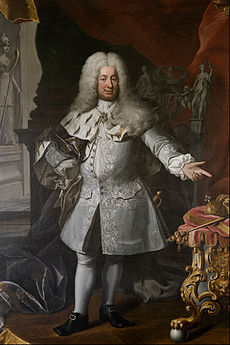This article needs additional citations for verification. (February 2012) |
| Frederick I | |
|---|---|
 Portrait by Georg Engelhard Schröder, c. 1730s | |
| King of Sweden | |
| Reign | 24 March 1720 – 5 April 1751 |
| Coronation | 3 May 1720 |
| Predecessor | Ulrika Eleonora |
| Successor | Adolf Frederick |
| Landgrave of Hesse-Kassel | |
| Reign | 23 March 1730 – 5 April 1751 |
| Predecessor | Charles I |
| Successor | William VIII |
| Prince consort of Sweden | |
| Tenure | 5 December 1718 – 29 February 1720 |
| Born | 28 April 1676 Kassel, Hesse-Kassel |
| Died | 5 April 1751 (aged 74) Stockholm, Sweden |
| Burial | 27 September 1751 |
| Spouses | |
| Issue more... | Frederick William von Hessenstein |
| House | Hesse-Kassel |
| Father | Charles I, Landgrave of Hesse-Kassel |
| Mother | Maria Amalia of Courland |
| Religion | Protestant |
| Signature | |
Frederick I (Swedish: Fredrik I; 28 April 1676 – 5 April 1751) was King of Sweden from 1720 until his death, having been prince consort of Sweden from 1718 to 1720, and was also Landgrave of Hesse-Kassel from 1730. He ascended the throne following the death of his brother-in-law absolutist Charles XII in the Great Northern War, and the abdication of his wife, Charles's sister and successor Ulrika Eleonora, after she had to relinquish most powers to the Riksdag of the Estates and thus chose to abdicate. His powerless reign and lack of legitimate heirs of his own saw his family's elimination from the line of succession after the parliamentary government dominated by pro-revanchist Hat Party politicians ventured into a war with Russia, which ended in defeat and the Russian tsarina Elizabeth getting Adolf Frederick of Holstein-Gottorp instated following the death of the king. Whilst being the only Swedish monarch called Frederick, he was Frederick I of Hesse-Kassel and thus Frederick I also of Sweden, though other Swedish monarchs with non-repeating names (such as Birger, Sigismund and Frederick's successor: Adolf Frederick) had not been enumerated.